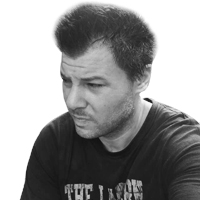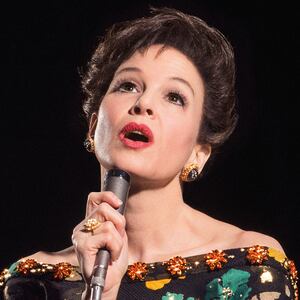As a straight man in his forties, I don’t really fit the expected demo of someone who's a massive Judy Garland fan, but I’ve been steeped in her work—in all of its wondrous range—going back to when I was a teenager. The girl who still represents the possibilities of movie magic turns 100 on June 10, 2022. Plenty will be made of The Wizard of Oz, which Garland famously starred in as a 17-year-old in 1939. It’s what most people know her for now—and, sadly, often all they know her for.
But I think it’s time that we reconsider Garland the versatile, singular artist. If we’re speaking about gifts, Garland belongs up there with any American artist or entertainer. One should have no compunction placing her alongside Mark Twain, Louis Armstrong, Orson Welles, or Emily Dickinson.
Her home as an entertainer was Hollywood, which didn’t exactly fit the bill as an over-the-rainbow Eden for Garland. Her own studio boss, Louis B. Mayer, often referred to her as “my little hunchback,” a frightening burst of misogyny that was subsequently never far from Garland’s mind for the remainder of her all-too-brief life. She died in 1969, aged only 47, of an accidental drug overdose, though close friends also remarked that she had simply been worn down to nothingness. Her personal possessions were auctioned off and brought in staggeringly low prices that are bound to make your soul sigh. And yet, there’s no dimming her artistry, which has the fascinating effect of burning brighter the more time one spends in its company.
ADVERTISEMENT
With the exception of Ella Fitzgerald, no American popular singer could touch Garland when it comes to vocal technique. She exuded perfection. There was no note past her range. Technique is something that singers all but kill for. You can help to teach it, but there’s only one way to master it, and that’s simply to have things that others don’t. But Garland was that rarest of singers whose technique was eclipsed by her emotional range, that quality within her that led to transcendent musical art. It’s the gift of connective emoting, making us feel as though we’re living out the story of this other person’s voice, like it exists for us and us alone.
Billie Holiday functioned in this humanistic vein, and it’s why her music endures. That Garland combined Fitzgerald’s chops with Holiday’s heart cuts her apart from just about anyone else. In 1958, paired with the arranger Nelson Riddle—who’d worked with the likes of Sinatra, Fitzgerald, and Nat King Cole—Garland cut Judy in Love. She went deep into the American Songbook, crafting an album that is itself a sustained hymn to the possibilities of song. She embodied “I Can’t Give You Anything But Love, Baby,” and to hear this record is to hear a form of vocal jazz in which the voice permeates the listener with the same efficacy of any trumpet solo Miles Davis ever fashioned.
And yet we don’t think of Garland as a jazz singer. Part of that is what we’ll call the Dorothy Effect, but it’s also because she was impossible to pin down. Dorothy was winsome, but her defining quality was her questing spirit. “Over the Rainbow” isn’t just arguably the most famous movie song there is, it’s a version of the blues. The way Garland sings it—especially on her 1961 live album Judy at Carnegie Hall—evinces a faith in finding one’s desired future, no matter how the path winds.
At the Carnegie Hall date, she seems almost embarrassed by the power she’s about to wield over the audience. There’s nothing arrogant in her words of introduction, her demeanor. She’s simply aware of what she can do, the level she can do it at, while not giving herself full marks for what is a form of genius.
As an actress, Garland was expected to smile, dance and sing, especially with Mickey Rooney, with whom she starred in ten films. She was a child star, but the catch was that Garland never much resembled a child. She was an adult at every age, who beheld the world around her with a child’s spirit of wonder. We should all be so lucky to remain that way at every juncture of our lives, but I think it put some people at odds with Garland. They were not that way—including much of the Hollywood brass—and they found it puzzling and threatening that she was. Even in The Wizard of Oz, we’re dealing with a young woman. She has the little dog, she looks up to her uncles, but this is also a grown-up person on the inside, who is going where she needs to go, wicked witches be damned.
There’s a difference between being a fighter and being truculent. Wanting to prove herself as a dramatic actress, she insisted that she wouldn’t sing in 1945’s The Clock, directed by future husband Vincente Minnelli. Critics looked at it as a downer after Meet Me in St. Louis the previous year—which is ironic given that film’s prevailing aspect of what I think of as a salubrious melancholia—but there isn’t a frame of the picture in which you don’t believe in Garland’s character.
The Clock is a movie about trying to find solidity within the evanescent framework of life, and the role that friendship and sacrifice play in the context of romantic love. What I especially admire about Garland is whether she’s singing or acting, in the myriad ways she did, she feels like a friend, as in a good guide. There’s nothing dogmatic about her. She has a light touch, without filching on emotion or undercutting the gravity of an issue. This is a Dickensian quality, and I think the more selfless an artist is, the more their work can do.
During this same period, there was a radio program called Suspense. It could be hit or miss. The show specialized in ghost stories, horror, crime—all manner of grisliness. There were a couple of guiding precepts: there’d be a twist at the end, which could be laughable, and the episodes would feature Hollywood stars cast against type. So, you’d have Jimmy Stewart, for instance, as this wife-hating, murderous doctor.
One of the best episodes featured Garland, and it stands up to this day as an example of sophisticated American radio art. It was called “Drive-In” and aired in January 1945. Garland’s character works as a waitress, hustling out to parked cars to take and deliver food orders. There’s not a moment when you think, “Hey! It’s Dorothy from The Wizard of Oz! What’s she doing slinging burgers and Cokes?”
That’s part of the Garland gift: instant believability, which is the same as feeling like we’ve automatically been transported somewhere. A guy who has just done something heinous gets paranoid and mistakenly thinks that this waitress is on to him. She’s harried by the stresses of life, her job, making ends meet, finding a way to catch her bus after her shift, and she agrees to let him give her a ride. Bad move.
I listen to this episode a lot, and recommend it to friends, because I never expect it to go the way it goes, and that’s because of Garland. The Suspense writers seemed to intuit that they didn’t need the twist this time, that this natural actress with that voice that always beckons us along for the journey would be all that anyone required. The ending is a gut-punch, and yet so triumphant. Garland doesn’t sing, but her voice does more than mere talking. It’s a feminist burst of recitative, a spoken opera in miniature. The floor is hers, but the listener is caught up, and invested, in the concept of ours.
I hear this, and I think we need to do a better job collectively of listening to Garland, and opening ourselves up to all that she was and remains in her art across the mediums. This isn’t creaky, old-time radio. It’s one of those Garland-esque power bursts, upending expectations. A mark of an artist is how well and how often they can surprise us, even if we think we know them. Garland continuously blows my mind, and I think my favorite example of how she does this is with a radio performance of “Have Yourself a Merry Little Christmas,” that number of numbers from Meet Me in St. Louis.
Garland is so fiercely human as to possess a dash more of a person than what we’re used to encountering. Maybe more than anything else, this is what an artist is. She’s nervous again, and doesn’t quite get the title of the song right before she tells us what she’s going to sing.
The rendition that follows makes me want to say, “Okay, game over,” because there’s little else to say. It’s like hearing Janis Joplin singing “Ball and Chain” at Monterey Pop in 1967. You have to gather yourself. Stand up, stretch. Take a walk around the block. Give some thanks that someone can do this. Nothing in your life really prepares you for this level of beauty. Prepare yourself, and find your way to Judy Garland. That’s the other side of the rainbow you want to get to. You’ll find a lot waiting there, and there’s nothing like it.







